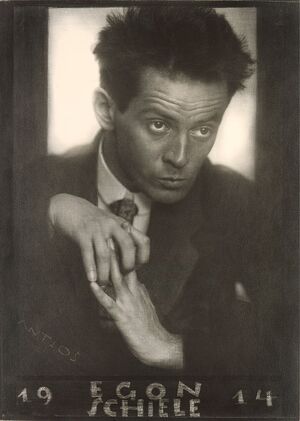Biography
Egon Schiele was an Austrian painter, a protégé of Gustav Klimt, and a major figurative painter of the early 20th century. Schiele's body of work is noted for the intensity and the large number of self-portraits he produced. The twisted body shapes that characterize Schiele's paintings and drawings make the artist a notable exponent of Expressionism. The most important collection of Schiele's work is housed in the Leopold Museum, Vienna.
Egon was born in 1890 at the train station Tulln on the Danube.[1] His father, Adolf Schiele, worked for the Austrian State Railways as a station master; his mother, Marie, née Soukup, was from Krumau, in Bohemia. As a child, he attended the school run by the Stift Klosterneuburg. He was tutored by art teacher Kari L. Strauch, who recognized and supported Schiele's artistic talent.
He had three sisters:
- Elvira Schiele (b. 1883 - d. 1893)
- Melanie Schiele (b. 1886 - d. 1974)
- Gertrude Schiele (b. 1894 - d. 1981)
In 1906, he attended the Kunstgewerbeschule in Vienna, where Gustav Klimt had once studied. Shortly after, at the insistence of several faculty members, he was sent to the more traditional Akademie der Bildenden Künste in Vienna.
In 1907, he sought out Gustav Klimt, who was a mentor to young artists. From 1907 to 1909, Schiele's works were strongly influenced by Klimt's style. His first exhibition was held in Klosterneuburg in 1908. The following year, he left the Academy and founded the Neukunstgruppe ("New Art Group") with other dissatisfied students. Klimt invited Schiele to exhibit some of his work at the Internationale Kunstschau in Vienna in 1909.
Upon leaving the Academy, Schiele's signature style began to develop and by 1910 he began experimenting with nudes, including his 1910 self-portrait Kneeling Nude with Raised Hands.
Controversy: Egon Schiele was the subject of controversy during his life. In 1911, he met Valerie (Wally) Neuzil, who was seventeen years old. She had previously been a model for Gustav Klimt and may have been his mistress. Valerie lived with Egon and modeled for some of his most striking paintings.
The couple moved to Krumau (his mother's hometown), which is a small town in southern Bohemia. However, they were driven away by local residents, who did not approve of their lifestyle, including his alleged employment of the town's teenage girls as models.
From there, they moved to Neulengbach, west of Vienna. His studio became a gathering place for delinquent children and again was disliked by local residents. In April 1912, he was arrested for seducing a girl below the age of consent and many of his drawings were seized, being deemed pornographic. He was imprisoned while he awaited trial. When he appeared in front of the judge, the charges of abduction and seduction were dropped. However, he was found guilty of exhibiting erotic drawings in a place accessible to children. The judge burned one of his paintings in court over a candle.
In 1914, he met Edith and Adele Harms, who lived with their parents across from his studio in Hietzing. On 17 Jun 1915, he married Edith Harms.
Days after being married, he was ordered to report to the army and was initially stationed in Prague. He never saw direct fighting. Instead he was a guard for Russian prisoners of war, which allowed him to continue painting.
In 1917, he returned to Vienna and began a prolific period of production.
Death: In 1918, the Influenza Pandemic of 1918-19 (aka Spanish Flu) reached Vienna. His pregnant wife Edith succumbed on 28 Oct 1918, and just three days later Egon Schiele met the same fate. During those three days, he produced several sketches of Edith. He is buried at Friedhof Ober Sankt Veit.[2]
Artistic Recognition:
1910: Group Show. Neukunstgruppe in Prague
1911: Several Secessionist shows in Munich.
1912: Group Show. Neukunstgruppe in Budapest
1912: Sonderbund, Cologne
1913: First solo show. Galerie Hans Goltz, Munich.
1914 Solo show. Paris.
1918: Secession Exhibition, Vienna. He had 48 works accepted, and they were displayed in the main hall. He also designed a poster for the exhibition. The show was viewed a success.
1918: Successful shows in Zurich, Prague and Dresden
Legacy:
His work was classified as Degenerate Art by the Nazi Party in Germany.
In addition to the Schiele Museum in Tulln, which is dedicated to him, his work is held by a number of renowned art institutions.[3]
- Leopold Museum, Vienna
- The Österreichische Galerie, Belvedere, Vienna
- Neue Galerie for German and Austrian Art, New York
Excess and Punishment was a 1980 biographical film about Schiele's life.
Schiele in Prison was a documentary film produced by the Arts Council of Great Britain in 1980.
Arrogance was a 1990 novel by Joanna Scott about his life.
Death and the Maiden (Egon Schiele: Tod und Mädchen) was a 2016 biographical film.
Richard Avedon, the fashion photographer, wrote an essay on portraiture entitled Borrower Dogs, which includes a discussion of Schiele's work.
Sources
- ↑ Egon Schiele Birthplace, Tulln. Accessed 9 Mar 2023 by Bizjak-2
- ↑ Find A Grave: Memorial #9962
- ↑ Schiele Museum, Tulln, Austria. Accessed 9 Mar 2023 by Bizjak-2
- Wikidata: Item Q44032

No known carriers of Egon's ancestors' DNA have taken a DNA test.
Have you taken a DNA test? If so, login to add it. If not, see our friends at Ancestry DNA.
S > Schiele > Egon Leo Adolf Schiele
Categories: Tulln an der Donau, Niederösterreich | Friedhof Ober Sankt Veit, Wien, Österreich | Painters | Notables


